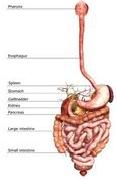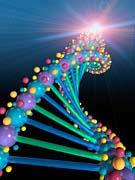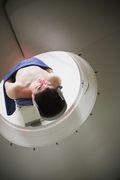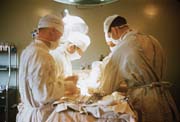An overview of pancreatic cancer including its causes, links to gum disease and fungi, and treatment options including drug combination FOLFIRINOX, and natural compounds such as Vitamin D, shikonin, feverfew, artemisinin, pancreatic enzymes, Dandelion Root Extract and off-label drugs like Itraconozole and Propranolol.
Read the whole article or click on the title below to read the piece(s) that you wish to view.
The Pancreas
 The pancreas is an organ deep in the abdomen, just in front of the spine, below the stomach and liver and in line with the lowest front ribs. It is about 6 inches long, pear-shaped and connected to the small intestine (the duodenum). It secretes pancreatic enzymes that help you to digest your food, and hormones linked to the control of your blood sugar and the metabolism of carbohydrates, most notably insulin and glucagon.
The pancreas is an organ deep in the abdomen, just in front of the spine, below the stomach and liver and in line with the lowest front ribs. It is about 6 inches long, pear-shaped and connected to the small intestine (the duodenum). It secretes pancreatic enzymes that help you to digest your food, and hormones linked to the control of your blood sugar and the metabolism of carbohydrates, most notably insulin and glucagon.
Pancreatic cancer has been associated with poor blood sugar control, insulin resistance and even type-2 diabetes. And with poor diet and gum disease!
 Want to receive the very latest 'news you can use' on pancreatic cancer?
Want to receive the very latest 'news you can use' on pancreatic cancer?
Click here
return to the top
Pancreatic cancer and cancer stem cells
If you have pancreatic cancer you should understand that some experts believe the very epicentre of cellular and cancer control in your body is under attack.
Scientists at Cancer Research UK have concluded that two proteins (CAP-G and Gelsolin) found in high concentrations in pancreatic tumours are normally responsible for cell movements around the body. Unfortunately, they contribute to pancreatic cancer’s aggressive ability to spread. Secondly, the pancreas is now appreciated to play a part in virtually all cellular growth control and differentiation, especially of stem cells (the precursor cells from which your body makes specific heart, stomach, kidney, breast cells etc). Stem cells are found all over the body. They are your natural ’repair cells’.
2018 research has indicated that pancreatic cancer is highly enriched with stem cell subpopulations that are resistant to current chemotherapy options and thus promote recurrence and aggressive metastases (1). This has prompted a number of researchers to look to natural bioactive compounds known to tackle cancer stem cells for answers (2). We have prepared a list of the top ten natural compounds (such as Ursolic Acid, lycopene, EGCG and turmeric) here. Another resource area being explored is off-label drugs that can also attack cancer stem cells (such as Doxycycline, Niclosamide and Accutane).
Pancreatic enzyme theory of cancer
The above findings are nothing new. In the article The Pancreas Strikes back you will read how in the 1970s an American, William Kelley, developed a theory from work by Dr. John Beard a Mancunian embryologist, and used it to treat and cure a large number of cancer patients using pancreatic enzymes, and how the late Dr. Gonzalez, a New York doctor, took it a further step with a clinic and, under FDA supervision, was treating and sometimes beating a number of different cancers including pancreatic cancer.
Of particular relevance was that he undertook Clinical Trials with his diet therapy, which included the tailoring of a large number of supplements including pancreatic enzymes to a patient’s biochemical type (metabolic typing). One UK Doctor working in this same area is Dr. Etienne Callebout in Harley Street.
return to the top
Causes of Pancreatic Cancer
Pancreatic cancer is a very serious cancer that is often diagnosed late and grows aggressively. It is the fourth largest cause of cancer death in the USA, for example, despite its low absolute numbers.
In 2015 9,921 people were diagnosed with pancreatic cancer in the UK, a rise of 12% in just 3 years. Almost all of the patients are over the age of 50. The causes of this cancer are becoming clearer all the time - a number of risk factors are emerging:
* A strong causal link has been shown with pathogens, particularly those in the mouth. Research from NYU Langone Medical Centre has shown that two bacteria linked to gum disease, are also linked to pancreatic cancer. People with Aggregatibacter actinomycetemcomitans were almost 50% more likely to get pancreatic cancer; and those with Porphyromonas gingivalis almost 59% more likely to get the disease. As long ago as 2007, there was a study from the Harvard School of Public Health and the Dana Faber Cancer Institute in the Journal of the National Cancer Institute linking Periodontal Disease with a higher risk of pancreatic cancer. We have known people with newly diagnosed pancreatic cancer sent by their oncologist to see a dentist straight away!
We have also covered research from the same medical school which shows that the development of pancreatic cancer is associated with a rush of pathogens from the gut into the pancreas. The levels of bacteria in the pancreas can increase a thousand fold!
A 2019 study showed that fungi (yeasts) called Malassezia were present in pancreatic cancer and a molecule carried on the surface (MBL) promoted carcinogenesis.
* Smoking is associated with increased risk probably one third of all pancreatic cancers have a link to smoking (Mayo Clinic) Alcohol consumption over long periods of time increases risk. The latter is one possible cause of chronic pancreatitis where the pancreas becomes swollen, and this can itself lead to the cancer.
 * Men and women with certain faulty genes may have a higher incidence. For example, the BRCA1 and BRCA2 genes were given those letters originally because they were previously thought to be linked just with breast cancer. Now that their role in DNA repair and immune system identification are understood, it is not surprising that they are associated with a number of cancers in both men and women. Some pancreatic cancers are associated with faulty genes and hereditary factors but this accounts for 7-10 per cent of the cancers at most.
* Men and women with certain faulty genes may have a higher incidence. For example, the BRCA1 and BRCA2 genes were given those letters originally because they were previously thought to be linked just with breast cancer. Now that their role in DNA repair and immune system identification are understood, it is not surprising that they are associated with a number of cancers in both men and women. Some pancreatic cancers are associated with faulty genes and hereditary factors but this accounts for 7-10 per cent of the cancers at most.
"Confused by it all? Want a programme tailored to you and your cancer?
GO To: Patient Feedback on Personal Programmes with Chris Woollams"
* Black people have more incidence of pancreatic cancer than white, and men more than women.
* It is becoming increasingly clear that Diabetes, insulin resistance and poor blood glucose control may be a factor. It certainly is with other cancers, but the pancreas has a special relationship with these because it controls sugar levels in the blood and carbohydrate metabolism. New research (Gastroenterology 2005; 129; 504-11) shows that elderly, late-onset diabetes patients, have an increased risk of pancreatic cancer within three years. Suresh Chari (Mayo Clinic) has suggested using late-onset diabetes as a marker to obtain an earlier diagnosis for pancreatic cancer. Type-2 diabetes is associated with a completely inflammatory set of gut bacteria and pathogens.
* MD Anderson have concluded that there is a link between stress, diabetes and pancreatic cancer. They have an excellent review at www.cancerwise.org. They state risks are higher for black people and Asians, for smokers and for people with a history of high blood sugar. They recommend exercise, controlling blood sugar and the avoidance of sugary or refined starch foods.
* A diet high in animal fat and low in fruit seems to increase risk.

* And thus Pancreatic cancer is linked to lifestyle factors including poor dietary habits (eating too many high glycaemic index foods, and to being overweight). There is good research showing that people who do not eat enough whole food fibre develop more pancreatic cancer. Again, this could come back to having the wrong gut bacteria - the good bacteria thrive on whole, soluble fibre foods like pulses, oats, and nuts and seeds.
* Finally, there is increasing evidence that some toxins may damage the pancreas. People working in the petroleum, oil and chemical industries and some farmers have a higher incidence. The hormones of the pancreas influence, and are influenced by, all other body hormones and thus chemical products in the blood stream that mimic them play a significant role Readers may wish to read As Safe as Houses and articles such as Toxic Toiletries to develop a clearer picture of what they might usefully avoid for total safety.
Now, we don’t list the causes so you can feel guilty. We list them so you can realise what factors might still be present and maintaining your cancer and so you can actually start to do something for yourself in parallel to your doctors’ work.
return to the top
Reducing the risk of pancreatic cancer?
So, what can you do? Start by ...
1. Avoiding gum disease, making regular visits to the dentist, using a (non-alcohol based) mouthwash - these have all been suggested by UK oncologists to pancreatic cancer patients. Perhaps it would be better to pay more attention to oral hygiene before pancreatic cancer develops?
2. Eating more whole foods and particularly high ’soluble fibre foods’ reduces risk. Avoiding being over-weight, and eating less junk food, empty glucose products, sugar, refined carbohydrates and processed food would seem to lower risk of both diabetes and pancreatic cancer.
3. Science Daily (Sept 12 2006) and Dr Mercola both report on a study which examines data from two large scale research projects. One project reviewed 45,000 men aged 40-75; the other, 75,000 women aged 38-65 in the USA. The study concluded that people taking 400 IUs of Vitamin D every day can reduce their risk by 86 per cent. It is now well known that Vitamin D has an important role in the fight against cancer. Sunshine is the best source, with fish oils like cod-liver oil or krill oil, a long way behind. But, if you cannot get into the sunshine for 2 hours a day, you really should supplement.
"If you are already looking for supplements go to the Natural Selection shop where they have selected the best of the best and you can buy with confidence. CLICK HERE."
4. Researchers at the German Institute of Human Nutrition have concluded that a diet rich in flavonols may dramatically cut slash your risk of developing pancreatic cancer.
The 8-year study showed benefits of about 25 per cent and 59 per cent if you were a smoker. Three types of flavonols were found to be very beneficial: Quercitin (apples, onions, garlic); myrecetin (red berries, plums, red onions); Kaempferol (greens, cabbage, spinach etc).
return to the top
Pancreatic cancer symptoms
The most frequent symptoms include:
-
Jaundice where your skin and eyes may turn slightly yellow, the skin may become itchy and your urine turn a dark yellow, even brown. Although this is more a condition of the liver, it is caused by the exit duct from the pancreas blocking the bile duct from the liver which it joins before passing to the intestine.
-
Pain in the abdomen or middle and upper back especially when lying down
-
Tiredness extreme fatigue
-
Weight loss
-
Digestive problems such as bloating, indigestion and wind after meals
Of course, any of these symptoms could be a sign of other ailments.
return to the top
Types of Pancreatic Cancer
The pancreas itself is divided into a head, a body and a tail.
About 85 per cent of all pancreatic cancers (adenocarcinomas) are found in the head region and arise in the acinar cells, where the enzymes and digestive factors are produced, or in the ducts taking the digestive juices to the intestine. This seems to be an important factor - see ’Two UK Professors reversing Type-2 Diabetes, below".
Rarer cancers are found elsewhere. For example:
-
Pancreatic Lymphoma in the lymphatic tissues
-
Pancreatic Sarcoma found in the structural tissue
-
Neuroendocrine pancreatic cancers arising in the hormone-producing islet areas. This was the cancer that Steve Jobs of Apple fame died from. But actually, many people with this cancer live 7 years or more; many die with this type of pancreatic cancer not from it. Steve Jobs did a number of very weird alternative cancer therapies that CANCERactive would NOT recommend.
return to the top
Pancreatic cancer diagnosis
Pancreatic cancer is difficult to detect. Your doctor will study the symptoms, feel for a swollen liver, conduct a blood test for a tumour protein called CA19-9, and send you for X-rays.
These tests may include:
-
Ultrasound - where a gel is used on your tummy, then a (why is it always so cold?) metal rod is simply passed over the top. Harmless sound waves then bounce off internal organs and, via a computer, images show on a nearby TV screen. Ultrasound may also be used in the process of taking a small amount of tissue using a long needle this is called a biopsy.
-
 CT scan where a number of X-rays are taken to build up a 3D computer picture of whole areas of the body. It will take as long as it takes to complete up to 30 X-rays ie about 30 minutes. You may be given an injection of a substance which allows the X-rays to be clearer; and your doctor should discuss allergies, asthma and iodine concerns with you before hand. CT scans may also be used when conducting biopsies. (NB: Too many CT scans should be avoided where possible. Research from Columbia University (icon Vol 3 Issue 4) calculated that the radiation produced from an annual CT scan risks a 1 in 50 chance of death. The risks of a full body scan are reasonably well quantified says Dr David Brenner)
CT scan where a number of X-rays are taken to build up a 3D computer picture of whole areas of the body. It will take as long as it takes to complete up to 30 X-rays ie about 30 minutes. You may be given an injection of a substance which allows the X-rays to be clearer; and your doctor should discuss allergies, asthma and iodine concerns with you before hand. CT scans may also be used when conducting biopsies. (NB: Too many CT scans should be avoided where possible. Research from Columbia University (icon Vol 3 Issue 4) calculated that the radiation produced from an annual CT scan risks a 1 in 50 chance of death. The risks of a full body scan are reasonably well quantified says Dr David Brenner)
-
MRI scan - similar to a CT scan, this uses magnetism rather than X-rays. You may be given an injection of a dye to allow more clarity in the images. You will be asked to lie still after sliding into a horizontal chamber. Some people find this very claustrophobic, especially as the tests can last for anything up to an hour. No metal objects (necklaces, pacemakers, metal plates from former operations) are allowed.
-
Chest X-Ray a normal X-ray to see if there is any spread to other body areas.
-
Biopsy where a number of cells, or some tissue, is taken for study under a microscope. Usually this is done using a long, thin, hollow needle under the guidance of images from a scan. A local anesthetic will be used. There have been articles in the Lancet that biopsy may actually spread a cancer if present. Ask.
None of these tests alone may be conclusive. Other tests that may be used include:
-
An ERCP where the doctor will use an endoscope (a tube with a light and a camera on the end, attached to a computer and a TV monitor. Only the tube goes inside you! A local anesthetic will be used, and the tube passed through your mouth, down your throat and into the bile and pancreatic ducts. A dye may be used to clarify the pictures and help identify any blockages. Antibiotics will then be provided as infection may well occur.
-
An EUS where an ultrasound probe is used rather than an endoscope
-
A Laparoscopy where the doctor makes a small incision just below your navel and a narrow tube complete with camera is passed inside the abdomen. A computer connected to a TV monitor shows the doctor the pictures of your internal organs. A biopsy may be carried out at the same time.
 Click here and read our article "What is Cancer"
Click here and read our article "What is Cancer"
return to the top
Pancreatic cancer stage and grade
Cancers are defined in terms of stage the spread of the cancer; and grade the aggressivity of the cancer. Each is on a 1 to 4 scale.
Stage 1 indicates that the cancer is confined and there is no spread
Stage 2 indicates that it has passed to surrounding organs like the intestine and bile duct
Stage 3 indicates it is now spreading in local tissues and into the surrounding lymph nodes
Stage 4 indicates that distant organs such as lung, liver and even brain may be infected.
return to the top
Treatments for pancreatic cancer
The problem with Pancreatic cancer is that, because it is so hard to detect, often it is not caught at an early stage and it has already spread.
 Surgery: may be used to remove a part of the pancreas, the whole of the pancreas, or even the pancreas plus surrounding tissues such as bile duct and even part of the stomach and small intestine, plus lymph nodes. None of the surgery options is minor, and there are diet and hormone implications following these options. Ask.
Surgery: may be used to remove a part of the pancreas, the whole of the pancreas, or even the pancreas plus surrounding tissues such as bile duct and even part of the stomach and small intestine, plus lymph nodes. None of the surgery options is minor, and there are diet and hormone implications following these options. Ask.
Chemotherapy: may be used to shrink the tumour prior to surgery, to try to confine the cancer to the pancreas, or to treat cancer in the body once it has spread. The most commonly used drugs include Cisplatin, 5-Fluorouracil, Mitomycin, Capecitabine and Gemcitabine - frankly, old fashioned chemotherapy drugs. You can find out more about each - click here.
A four drug cocktail has shown to extend life by a couple of years in a Clinical Trial in France - Dr. Thierry Conroy of the Cancer Institute in Nantes gave 493 patients either gemcitabine (Gemzar), the current US Standard of Care, or FOLFIRINOX - oxiplatin (Eloxatin) + leucovorin (foiling acid) + irinotecan (Camptosaur) + 5 - Fluororacil (Adrucil). Average survival rose from 35 months to 54 months.
Immunotherapy and pancreatic cancer - Almost all work is at the Clinical Trial stage unfortunately - with monoclonal antibodies and checkpoint inhibitors being used.
Radiotherapy: is sometimes used to help kill local cells but there is a risk to nearby organs from the beam. Proton Beam Therapy would seem a much better bet.
return to the top
Alternative and complementary treatments for pancreatic cancer
Cancer of the pancreas currently (2018) on the Internet seems to be all ’gloom and doom’.
But there are several potential natural treatments for pancreatic cancer:
1. Kill the Pathogens - Yes, it’s a good idea to go to a Dentist and fix your gums, teeth and oral hygiene straight away. Some UK oncologists already recommend this. You should immediately look to rebuild your gut microbiome.
 Go to: Chris Woollams’ book, ’Heal your Gut, Heal your Body’
Go to: Chris Woollams’ book, ’Heal your Gut, Heal your Body’
This book will explain to you how to rebuild your gut and get rid of these pesky pathogens.
Pathogens can be killed by the herb Artemisinin. While yeast infections (like Malassezia) can be killed by artemisinin, or common yeast killers like oregano oil, caprylic acid, pau d’arco and cinnamon.
Go to: Artemisinin kills pathogens and cancer cells
2. Off-label drugs.
There are a number of old drugs with very limited side-effects, originally developed for other illnesses but which now seem to have potential to fight pancreatic cancer - Itraconozole (a yeast killer) and Propranolol (a general beta-blocker which calms the inflammation in the body) seem interesting. You should look at this article:
Go to: How to build an off-label drugs protocol
3. Several Bioactive natural compounds have been shown capable of killing Pancreatic cancer cells.
i) Dandelion Root Extract has research showing it can kill pancreatic cancer cells.
Go to: Can Dandelion Root Extract fight cancer?
ii) Shikonin, a Traditional Chinese Medicine has been used by the University of Manchester to increase calcium and kill pancreatic cancer. The researchers described calcium as the 'Achilles Heel of pancreatic cancer'.
Go to: Pulling the plug on pancreatic cancer
iii) The herb Feverfew - and particularly its constituent parthenolide - has been shown to kill pancreatic cancer cells by attacking Nuclear Factor Kappa-B. It has a proven effect against cancer stem cells.
iv) Ayurvedic herb Holy Basil as a leaf extract has shown the ability to kill pancreatic cells in vitro but also it exhibits tumorigenicity and stops metastases in mouse models. This in vivo finding has been somewhat of a breakthrough. Holy Basil contains 3% ursolic acid. This is known to kill cancer stem cells and their are higher levels of these in pancreatic cancer than other cancers. Curcumin, lycopene, resveratrol are other natural compounds that attack cancer stem cells.
v) Thymoquinone - a constituent of the traditional Middle Eastern herbal remedy Black Cumin Seed oil (Nigella sativa) - blocks pancreatic cell growth and enhances programmed cell death according to researchers at the Kimmel Cancer Centre at Thomas Jefferson in Philadelphia.
vi) Triptolide - a constituent of Traditional Chinese Herbal Medicine Thunder God Vine (Terpterygium welfare) has been shown by researchers at the University of Minnesota to turn off a protein GRP78. This protein stops cells dying but is found in extremely high levels in pancreatic cancer cells.
vii) Chinese Herbal Medicine (CHM) could well be an answer. Research from Taiwan showed that people with pancreatic cancer who used CHM survived significantly longer than those who did not. Bai-hua-she-she-cao (Herba Oldenlandiae; Hedyotis diffusa Spreng) was the most commonly used single herb, while Xiang-sha-liu-jun-zi-tang (Costus and Chinese Ammonia in combination) was the most successful Chinese herbal formula taken.
viii) Dioscoreaceae - the Yam family of plants - contains a bioactive ingredient called methyl proxtodioscin, or MPD. This compound has been shown to have lipid-lowering, anti-inflammatory and anti-cancer properties. The National Cancer Institute has confirmed these anti-cancer properties of cytoxic activity, cancer cell cycle arrest and apoptosis. 2018 research has shown that injections into mice with pancreatic cancer greatly reduced glycolysis (the energy production system of cancer), reducing proliferation and promoting cancer cell death.
ix) Ginger - particularly two of the bioactive constituents gingerol and shagaol - has been shown to have potent anti-cancer effects against several subtypes of pancreatic cancer cell lines. The ginger seems to create Reactive Oxygen Species in the cancer cells which result in their death.
4. Two UK Professors - Roy Taylor and Mike Lean - have been reversing type-2 diabetes using a non-starchy vegetable juice diet. Yes, really. It reduces levels of fats like triglycerides and cholesterol that build up in the liver, then pass into the blood, then surround the pancreas stopping production of insulin. This could potentially stop production of pancreatic enzymes too. And type-2 diabetes and pancreatic cancer have strong links.
Go to: How two professors used a juice diet to reverse pancreatic fat blockages
Go to: Pancreatic, digestive enzyme combination
And this takes us back to the work of Dr. Nicholas Gonzalez!
return to the top
Complementary therapies and alternative therapies for pancreatic cancer: an overview
CANCERactive is Europe’s Number 1 Integrative Cancer Charity. This Website alone has more than 4,000 pages of information on it, either as articles or as news stories. More than 10,000 people visit our websites every day. We know from the feed-back we receive just how much we are valued by people trying to beat cancer.
We believe you can increase your personal odds of cancer survival by taking simple health-enhancing steps and adding both complementary cancer therapies and alternative cancer therapies into your mix of treatments.
For example, Hyperbaric Oxygen, curcumin, calorie restriction, melatonin, probiotics and whole body hyperthermia have all been shown in research to make chemotherapy work better. It then kills more cells! The research is covered on this website. Surely it makes a lot of sense to use them in your personal cancer treatment programme?
Go to: How to improve your chemotherapy
We cover how to improve your radiotherapy (and reduce side-effects) too.
Go to: Improve your Radiotherapy, and reduce side-effects
We have a complete review of Immunotherapy telling you the accurate figures and what to watch out for. We tell you what is working and when two new drugs have been used, rather than one. It’s a new, emerging and alternative cancer therapy, but not fully there yet!
Then we have an article on how to improve the success of your radiotherapy (and reduce the potential side-effects) – all by adding complementary therapies. Our Guidelines on Diet and Exercise can be found through this link:
Go to: CANCERactive Guidelines on Diet and exercise
Our recommended anti-cancer diet is the colourful Mediterranean Diet (with its focus on the French paradox):
Go to: The Rainbow Diet
Like Hippocrates, we believe all cancer begins in the gut and that gut problems, yeast, viral and parasite infections are common constituents of cancer.
Go to: All cancer begins in the gut
But if you just want to look at the most comprehensive list of Complementary Therapies you can find it here:
Go to: CANCERactive Complementary and Integrative cancer therapies
And if you want alternative cancer therapies start here:
Go to: CANCERactive Alternative cancer therapies
Finally, if you want all this put together for you in one simple plan, why not look into having a Personal Prescription?
Go to: Personal Prescriptions with Chris Woollams
We don’t take one penny from any Pharmaceutical company, cancer clinic or supplements company. We have no vested interest. We just want to see you beat cancer.
"If you are already thinking of supplementing with any of the above products, why not take a look at Our Natural Selection by clicking here."
The CANCERactive Difference:
Intelligent Information. Independent Voice.
return to the top
Refs
- Cancer Stem Cell 2014;14, 275 - 291. Kresco, Dick et al.
- https://www.researchgate.net/publication/327489224_Drug_Discovery_from_Natural_Products_for_Pancreatic_Cancer